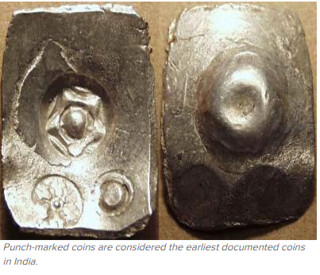
PREV ARTICLE
FULL ISSUE
PREV FULL ISSUE
PUNCH-MARKED COINS IN INDIA
This March 31, 2016 article from The Times of India discusses how punchmarked coins replaced the barter system in that country.
-Editor
The next step was to decide the authority who could assign these guarantee marks on the metal piece. Eventually, the ruling king of the concerned territory was given power to issue coined money. Punch-marked coins are considered the earliest documented coins in India, according to P V Radhakrishnan, curator at RBI Monetary Museum, Mumbai. "These coins are mostly made of silver, and bear various symbols, each of which is punched on the coin with a separate 'punch'. The date generally accepted for these coins is the beginning of the 6th century BC," he said, while speaking on "Significance of the symbols on ancient Indian coins and un-inscribed coins of Tamil Nadu from 500 BC to AD 300," at the department of ancient history and archaeology, University of Madras, on Wednesday. The scholars who studied this series classified them into two groups, local and universal. "The local punch-marked coins generally carry one, two or four symbols and were issued in different weight standard, fabric and execution, varying in different regions or localities. These coins are ascribed to various small and large states (janapadas and mahajanapadas), many of which existed in India from early times," he said. The imperial punch-marked coins, according to Radhakrishnan, uniformly bore five symbols. These coins were issued first by the Magadha dynasty when it was still a janapada. Gradually, Magadha extended its dominions by annexing neighbouring states and became a powerful monarch. "By the time of Ashoka, the Magadhan empire had spread over most of the Indian subcontinent. Its coins also spread with the empire's expansion and have been found in large numbers across the length and breadth of the Mauryan Empire, from Western Afghanistan to today's Bangladesh, and from the Himalayan foothills to the Deccan. The silver punch-marked coins also travelled beyond the Mauryan territory to the Chera, Chola and Pandya kingdoms of South India and to Sri Lanka due to the spread of Buddhism and extensive maritime trade," he said. To read the complete article, see:
The Numismatic Bibliomania Society is a non-profit organization promoting numismatic literature. See our web site at coinbooks.org. To submit items for publication in The E-Sylum, write to the Editor at this address: whomren@gmail.com To subscribe go to: https://my.binhost.com/lists/listinfo/esylum All Rights Reserved. NBS Home Page Contact the NBS webmaster 
|
